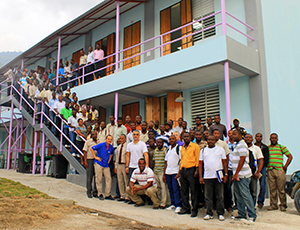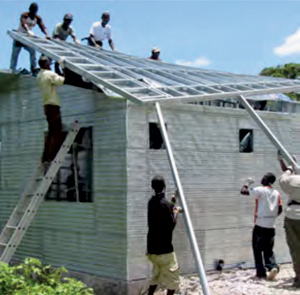

An old Chinese proverb sums up several projects that mark the dawn of seismic-resistant design and construction in earthquake-devastated Haiti: "If you give a person a fish, you feed that person for a day. If you teach a person to fish, you feed that person for a lifetime."
The aim of the projects—one of which concentrates on training for seismic design of commercial buildings and the other on the manufacture of hurricane- and seismic-resistant manufactured single-story buildings—is to prevent a repeat of the kind of death and destruction that occurred on Jan. 12, 2010, when a magnitude-7 quake killed an estimated 316,000 people and turned most buildings into rubble.
New York state's University at Buffalo, through its Multidisciplinary Center for Earthquake Engineering Research, and Shelter2Home LLC (S2H)—a building systems manufacturer—are "teaching people to fish" in very different ways. Since May 2010, UB/MCEER, in partnership with the private, non-profit Université Quisqueya (UniQ) in Port-au-Prince, Haiti's capital, has held four of five seminars on the fundamentals of seismic design.
Shelter2Home, a for-profit enterprise, is fabricating hurricane- and seismic-resistant houses and simple, single-story buildings based on its patented light-gauge steel framing system, engineered and constructed for seismic resistance. The firm hires and trains local workers to assemble the units.
Starting From Scratch
The UniQ-UB program has trained more than 500 architects and engineers, which is about 50% of the designer population in Port-au-Prince, a city of three million people. "Earthquake engineering and seismic design were non-existent in Haiti," says Andre Filiatrault, curriculum coordinator for the UniQ-UB/MCEER seminars and former director of UB/MCEER. "We were starting from scratch."
"Rebuilding in Haiti is a difficult, painful process," adds Filiatrault, who is also a UB professor of engineering. "The infrastructure is not there, and there's lots of inertia and corruption. … People don't always want to hear about earthquake engineering."
"One has to have a thick skin and a durable stomach to be in business in Haiti," says Donald A. Stevens, president of Shelter2Home, Winchester, Va. "It's a challenging environment."
UniQ-UB seminar attendee Yves Osias agrees that the environment is challenging. Materials are expensive and often substandard, and there is no enforcement of quality, says Osias, a Haitian structural engineer with the non-governmental organization Compassion International, Port-au-Prince. Reinforcing steel does not meet international standards, and workers are not qualified because there is not enough training in seismic construction.
Haitian native Gael Lamothe, a junior in civil engineering at UB, knows about materials firsthand. He recently completed a research project that compared 15 concrete masonry units (CMUs) produced by several suppliers in Haiti to six made in the U.S. Only one sample from Haiti met the U.S. standard. The other 14 had much lower compressive strengths.
"Engineers, architects and contractors are aware of the importance of seismic designs throughout Haiti," says Evenson Calixte, dean of UniQ's school of sciences, engineering and architecture. "However, the government has not yet shown any public policy toward the enforcement of seismic design in new construction."




Post a comment to this article
Report Abusive Comment